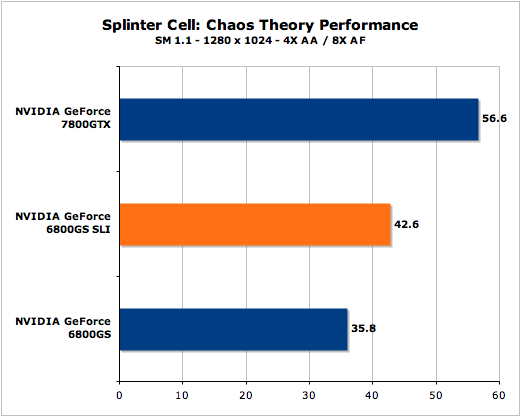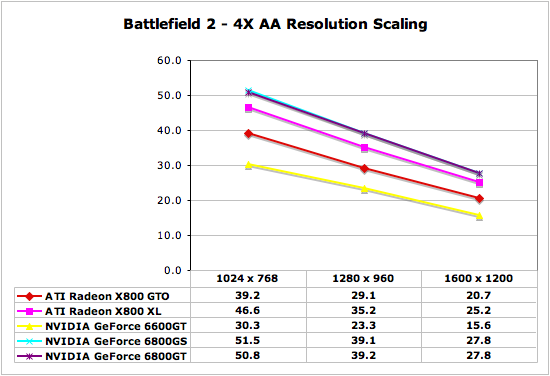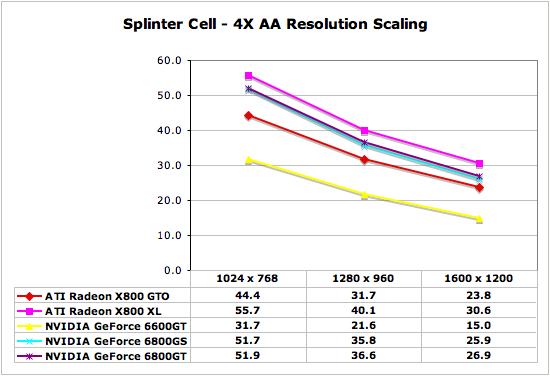The Holiday Stop Gap: GeForce 6800 GS
by Derek Wilson on November 7, 2005 9:00 AM EST- Posted in
- GPUs
SLI and Antialiasing
SLI can end up nearly doubling performance in some cases. In those cases we will see two 6800 GS cards deliver performance on par with a single 7800 GTX. But much more of the time we will see only a modest performance gain from SLI. Since one 7800 GTX costs about the same as two 6800 GS cards, we have to strongly recommend against going with 6800 GS SLI. If performance is desired and the money is there, the 7800 GTX is the better buy by a long shot.
The memory bandwidth of the 6800 GS makes antialiasing possible on most games at 1280x1024 and below. At higher resolutions, AA performance might not be where we would like. Games like Half-Life 2 will certainly run fine on a 6800 GS with AA enabled at 1600x1200. But the SC:CT and BF2 tests we ran show that the 6800 GS just doesn't have what it takes to make 1600x1200 with 4xAA a reality.
SLI can end up nearly doubling performance in some cases. In those cases we will see two 6800 GS cards deliver performance on par with a single 7800 GTX. But much more of the time we will see only a modest performance gain from SLI. Since one 7800 GTX costs about the same as two 6800 GS cards, we have to strongly recommend against going with 6800 GS SLI. If performance is desired and the money is there, the 7800 GTX is the better buy by a long shot.


The memory bandwidth of the 6800 GS makes antialiasing possible on most games at 1280x1024 and below. At higher resolutions, AA performance might not be where we would like. Games like Half-Life 2 will certainly run fine on a 6800 GS with AA enabled at 1600x1200. But the SC:CT and BF2 tests we ran show that the 6800 GS just doesn't have what it takes to make 1600x1200 with 4xAA a reality.












70 Comments
View All Comments
flynnsk - Monday, November 7, 2005 - link
lol talk about fangurlshttp://www.monarchcomputer.com/Merchant2/merchant....">http://www.monarchcomputer.com/Merchant...p;Store_...
imaheadcase - Monday, November 7, 2005 - link
You include shipping into "available today".Let me guess you got kicked out of Best Buy for yelling you can get hardrives for $1 less online..
bob661 - Monday, November 7, 2005 - link
I have NO idea what you guys are looking at.Quantity in Basket: none
Code: 190443
Price: $229.00
FedEx Ground: $5.90
In Stock - Usually ships in 1-2 days
bob661 - Monday, November 7, 2005 - link
Again, here's the http://tinyurl.com/clxpf">link.ViRGE - Monday, November 7, 2005 - link
It'll be up to ATI I suppose. As it is right now, Nvidia's products tend to fall in price quickly over the first month, so as Derek pointed out, the 6800GS is going to be a ~$220 card in a bit. I'm not sure ATI has enough latitude to get the X800XL's prices that low across the board.HighCalibreHooch - Monday, November 7, 2005 - link
Whatever happened to the 6800XT?It was announced some time ago, and oOne of my favourite vendors lists it as coming mid-November.
pxc - Monday, November 7, 2005 - link
It comes faster than stock: 470MHz core, 550MHz memory (1100MHz effective)https://pnyestore.pny.com/AWWebStore/Products.asp?...">https://pnyestore.pny.com/AWWebStore/Products.asp?...*PNYPRODUCTS
(or is it 425MHz? 5.1GT/s fillrate implies a 425MHz core even though 470MHz is listed: http://www.pny.com/products/verto/performance/6800...">http://www.pny.com/products/verto/performance/6800...
unfortunately the 6800GT PCI-E with 16 pipelines is only $250AR now ($30 cheaper):
http://www.buy.com/prod/PNY_FX_6800_GT_256MB_PCI_E...">http://www.buy.com/prod/PNY_FX_6800_GT_...Graphics...
yacoub - Monday, November 7, 2005 - link
I'll never understand why companies bother with this type of release. It has less pipelines and less engines, yet costs about the same as a 6800GT which has more of both. Why would anyone get this when they can grab a 6800GT?Same thing with those GTO cards when there's the X800XL or whatever.
yacoub - Monday, November 7, 2005 - link
oops, not GTO, I mean "X1600 series, when there's the GTO series and X800XL that are just as fast if not faster."Donegrim - Monday, November 7, 2005 - link
Same performance, much cheaper. It's obvious.